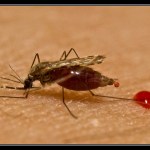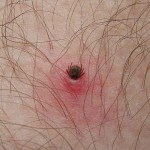blood
Here is the 4th most popular post so far this year:
Picture of a komodo dragon by CC BY-SA 3.0, via Wikimedia Commons
Researchers studying komodo dragons (Varanus komodoensis) at George Mason University discovered 48 previously unknown peptides in their blood that might have antimicrobial properties. Their findings were published in the Journal of Proteome Research. For the largest lizard, these peptides may help prevent the animals from getting infections from their own saliva, which is host to at least 57 species of bacteria. With this number of bacteria, it is …
This is such a beautiful award-winning image of the complex vascular networks in a pigeon. The image was captured using CT scan technology and a novel contrasting agent called BriteVu that allows visualization of even tiny capillaries. This image was captured by Scott Echols who is a member of the Grey Parrot Anatomy Project, whose goals are to create technologies to study animal anatomy. The complex capillary network located in the neck of this pigeon is important in helping the animal regulate body temperature. Dilation of these blood vessels allows the birds to…
Image of mosquito from http://bloodinurineandpainofca.wordpress.com/
Until now I thought I had come up with enough reasons to dislike mosquitoes, those tiny little blood sucking vectors of disease. With reports of the debilitating mosquito-borne virus chikungunya in the Americas (Carribean), I was ecstatic hear that researchers are working hard to find ways to control mosquito populations. As mentioned in a previous blog, only the females bite to obtain nourishment for developing eggs. According to the study authors, the female mosquito can double her own body weight after just one meal,…
Image of a tick stealing a meal from: www2.outdoorchannel.com
Ticks are blood-sucking arthropods that can act as vectors for various diseases in both animals and humans. A recent article published in Frontiers in Zoology summarizes findings that suggest ticks may also be considered venomous ectoparasites. For example, Ixodes holocyclus is a species of Australian tick whose saliva can induce paralysis in humans and animals. According to the new article, about 8% of known tick species can induce paralysis. Ornithodoros savignyi ticks even secrete a lethal…
Researchers in Romania have created a blood substitute with oxygen-carrying capacity using a protein called hemerythrin isolated from sea worms. This blood substitute has shown promise in studies of mice.
In East Africa lives a species of spider that drinks mammalian blood. But fear not - Evarcha culicivora is an indirect vampire - it sates its thirst by preying on female mosquitoes that have previously fed on blood themselves.
Even though its habitat is full of non-biting midges called "lake flies", it can tell the difference between these insects and the blood-carrying mozzies it carries. Robert Jackson from the University of Canterbury discovered this behaviour a few years ago and one of his colleagues, Fiona Cross, has now found that the blood isn't just a meal for the spiders, it's an…
The Lady of Broken Hearts
Natalie Shau
Lithuanian artist Natalie Shau works in digital media, mostly using Photoshop. You can see more of Shau's work at her website and at the website of jewelery designer Lydia Courteille, for whom she illustrated a cabinet-of-curiosities themed ad campaign. hat-tip: Haute Macabre.
There is an updated version of this post here: "Is Blood Ever Blue, Science Teachers Want To Know!"
According to one of the leading experts on the human circulatory system, blood flowing through veins is blue.
I'm not going to mention any names. All I'll say is this: A person I know visited a major research center last year and saw a demonstration of organ removal and some other experimental stuff. A person also visiting asked the famous high-level researcher doing this work if blood was ever blue. What he said was not recorded in detail, but it was very much like this statement I found…
There is an updated version of this post here: "Is Blood Ever Blue, Science Teachers Want To Know!"
Why ask the question, "Is blood ever blue?"
According to one of the leading experts on the human circulatory system, blood flowing through veins is blue.
I'm not going to mention any names. All I'll say is this: A person I know visited a major research center last year and saw a demonstration of organ removal and some other experimental stuff. A person also visiting asked the famous high-level researcher doing this work "Is blood ever blue?" What he said was not recorded in detail, but it…



